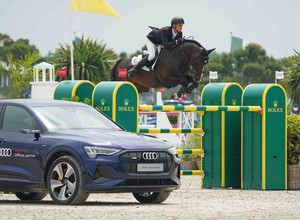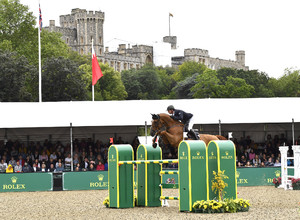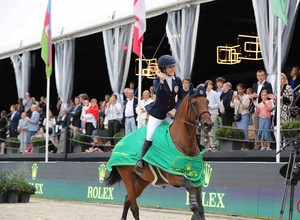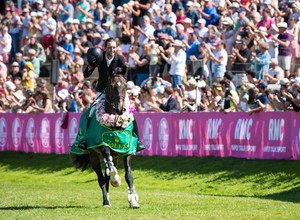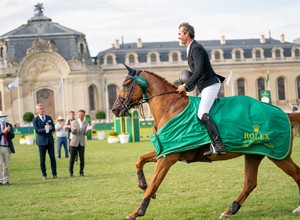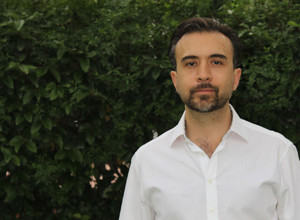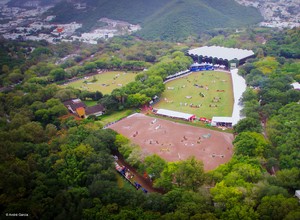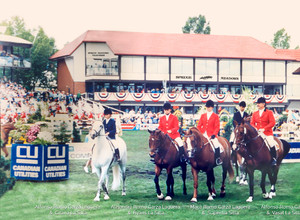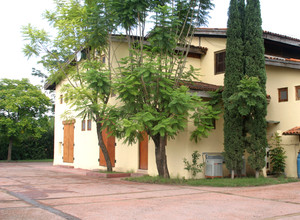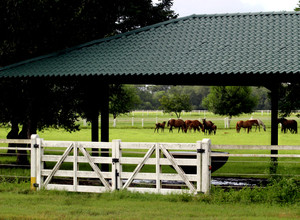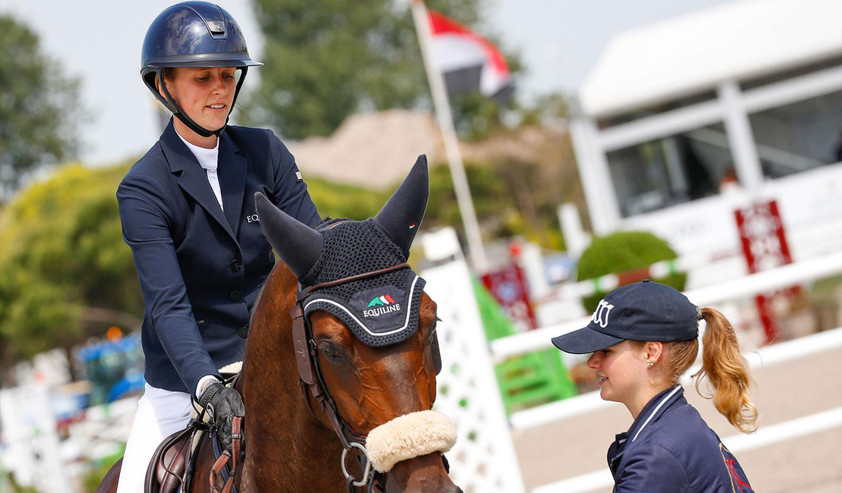The Summer Rolex Grands Prix Season Results
The period between 2021’s first two Rolex Grand Slam Majors – The Dutch Masters in April and the CSIO Spruce Meadows ‘Masters’ in September – played host to no fewer than five top-class show jumping events, each featuring a prestigious Rolex Grand Prix as the pinnacle class of the show, which attracted the world’s very best riders and horses.
The 1m60 Rolex Grand Prix presented by Audi concluded five days of entertaining jumping from 23-27 June at Knokke Hippique in the north-west of Belgium. After nine riders progressed to the jump-off, local hero and Tokyo 2020 Team bronze medallist, Jérôme Guery, and his bay stallion, Quel Homme de Hus, proved far too strong for the rest of the field, finishing over six seconds ahead of second-placed riser and Rolex Testimonee, Kevin Staut.
Royal Windsor Horse Show’s crowd in the iconic Castle Arena in the shadow of Windsor Castle witnessed a dominant display of horsemanship on 4 July, after another local hero, Ben Maher, and his extraordinarily talented stallion, Explosion W, took the honours in the CSI5* Rolex Grand Prix ahead of Swiss Rolex Testimonee, Steve Guerdat. The Briton’s next stop would be Tokyo 2020, where he and his dependable equine partner were eventually crowned Individual Olympic champions.
Rolex was warmly welcomed to The Masters of Chantilly, as the show’s Official Sponsor, Official Timepiece and Title Sponsor of the Grand Prix. Staged on the manicured lawns of the Hippodrome de Chantilly from 6-11 July, it was Nicolas Delmotte, who brilliantly continued the local hero theme. The Frenchman and his gelding, Urvoso du Roch triumphed by just 0.36 seconds over Swiss Martin Fuchs, yet another Rolex Testimonee who had to settle for second place.
Brittany’s Emerald Coast provided an exquisitely picturesque location for Jumping International de Dinard as spectators were welcomed back in the tribunes from 15-18 July, where Fuchs superbly made amends for his Chantilly disappointment. Paired this time with his gelding Connor 70, the current Individual world champion pipped Ireland’s Denis Lynch to top spot in the show’s finale, the CSI5* Rolex Grand Prix de Dinard.
The Brussels Stephex Masters 2021 climaxed on Sunday 29 August with its showpiece class: the CSI5* Rolex Grand Prix presented by Audi. After nine combinations progressed to the jump-off, after navigating the 13-obstacle, Uliano Vezzani-designed course fault-free, it was the USA’s Jessica Springsteen and her 14-year-old mare, Rmf Zecilie who prevailed by a tenth of a second over Germany’s Daniel Deusser, with Italy’s Lorenzo de Luca slotting into third place over a second further back.
Breeders Uncovered with the Studbook La Silla
Please tell us about the history of La Silla
Pilar Cepeda Yzaga (P) – “Alfonso Romo started La Silla in Monterrey, Mexico. At the time, we were extremely lucky to have talented mares such as Doreen LS – who competed at the Olympic Games – at the farm. As the mares got older and retired, we felt so privileged to have competed them and thankful for all that they had done for us that we did not want to sell them. So, we decided to breed from them instead, and this is how La Silla was born. Over the years, the breeding programme started to expand, as Poncho [the nickname of Alfonso Romo] bought top-class show jumping mares, such as Dollar Girl, Renata, Carrera, Quinta, and Olympica (Ninja’s mother).
“In the times when La Silla was founded, it was impossible to buy semen from a foreign country due to customs’ rules. Therefore, that is why there are some La Silla horses in France. Every year we would send a few of the mares over to France to have one or two foals from different stallions. The customs’ rules have changed recently, and over the last two years we have been able to import semen from Europe. Personally, I think this will have a significant effect on breeding in Mexico.”
What is the proudest moment in the history of La Silla?
P – “I think that it would be impossible to highlight just one moment. We have been incredibly blessed to have had such wonderful horses and results from the La Silla programme. One moment, of which we were incredibly proud was when Rodrigo Pessoa finished fourth with Rebozo LS at the World Championships. This was very meaningful to us, as the mother (Renata) is one of our favourite horses and is one of our best breeding lines.
“We have horses competing for numerous nations at the biggest and best shows. We are of course so proud of these horses, but we also get so much satisfaction and pride seeing our horses jumping at the smaller national shows or with young riders. For example, one of La Silla’s mares recently won a gold medal at the North American Youth Championship in Michigan. It truly is impossible to pick one moment – you remember all of them with passion and feeling.”
Alejandra Romo Garza Lagüera (A) – “We have been lucky to have had so many proud moments. Breitling LS, ridden by Beezie Madden, winner of the World Cup Jumping Final in Paris in 2018, and Team and Individual bronze at the Pan Am Games, Peru in 2019. Also, Chela LS, who was ridden so beautifully by Ashlee Bond Clarke at the $1 million Grand Prix at HITS Thermal in 2014.”
Could you explain the operation at La Silla?
P – “We are a studbook and a farm. We have amazing veterinary facilities on-site with excellent staff, such as Juan José Vazquez, who is our leading equine reproduction specialist vet. He looks after the embryos and is key to our programme. We have been incredibly lucky to have numerous people from Europe and the United States of America, who give us advice so that we can continue to learn and improve our programme here in Mexico. Dr. Irwin Liu in the United States of America has given us all of the necessary knowledge in regard to the correct and proper treatment of embryos.
“We do not breed from the mares before they are four years old, which is uncommon in Europe where they breed much earlier. We believe the horses grow until they are six, so they need more time to develop before they have foals. We know all the mares so well, as we ride, compete and look after them, and this enables us to understand which horses should be bred from, to ensure that we continue to produce the best we can.”
A – “We have our staff working on this programme, including an agricultural engineer, veterinarians, grooms and riders in charge of the horses. We pair the riders and the horses together based on their individual attributes and evaluate this partnership over time. We have a very considered approach to how we start our horses, and unlike other places, we wait until they are either four or five years old. This decision is made in conjunction with our veterinary team, who advise us on the bone structures and confirmation of each of the horses. Our vets are truly top-class, and we often have horses who are not from La Silla coming to be cared for by the team.”
Have you ever had any unexpected results from the breeding programme?
A – “One time, we had a mare who was a bit slow. In my opinion she needed to be paired with a horse with a lot of ‘blood’. My brother chose a stallion who was not ‘bloody’ at all. I thought he had chosen the wrong stallion, but the foal turned out to be very ‘bloody’, which was a lovely surprise. At the end of the process we always say a prayer and trust everything will be for the best.”
P – “You can choose the best mare and stallion, but at the end of the day nature and god will always play such a strong role that you cannot predict the outcome.”
The partnership between horse and rider is very important, is this something you look at when you sell to new owners?
P – “I think that it is most important to have a good reputation, so this process is critical. Unfortunately, as breeders, we cannot always control the clients, as they bring their trainers who advise them. You have to be straight and honest.”
A – “I like to ask a lot of questions when someone comes to buy one of our horses. I really need to know the type of rider and the needs that that rider will have. Amateurs and professionals have very different needs and wants from their horses, so really understanding the individual is crucial when pairing a horse and rider. We love to see our horses reach their full potential, so matching the correct rider with correct horse is such an important process for us.”
How many horses are you breeding in a normal year?
P – “La Silla itself used to breed 120 foals; we have now reduced to about half of that because of the pandemic. There are less shows, and therefore there is less demand, so that is why we are breeding fewer foals.”
A – “I would say about 50 [per year] in the last few years is normal.
What are your other ambitions for La Silla? Why do you do it?
P – “Alfonso Romo made it possible for Mexican people to have good horses. Back when La Silla was founded, Mexicans mainly used Thoroughbred horses to show jump. These could not compete on the same level as the Warmbloods bred in France and Germany. Poncho decided to help equestrianism in Mexico, and that’s one of the reasons La Silla started its shows. If you look at any of the results from national shows and championships in Mexico, you will see numerous La Silla horses at the top of the leader boards.
“Many of the world’s top riders jumped at La Silla’s junior shows. Now, we want to attract them back. It is challenging because Mexico is so far away. We are aiming to return La Silla to its standard as one of the best shows and to attract top level sport, and top horse and rider combinations to Mexico.”
A – “We would love to host a top-level show here. We aspire to be like Aachen or Spruce Meadows and create an incredibly special venue and be recognised as a world-leading show.”
How positive do you believe the Rolex Grand Slam is for the sport of show jumping?
A – “I think the worldwide reputation of Rolex is massive. Rolex’s brand is perpetual, it is precision, and the shows are like that. It is an inspiration for us and others, it is what we aim to be like. It has done so much not only for show jumping but for all the equestrian disciplines.”
P – “I think it’s been incredible for the sport. The epitome of elegance beauty and top level sport. Riders and owners want to be there, so often they plan their whole year to aim for these competitions. I believe that young riders dream about winning a Rolex Grand Slam as they do an Olympic medal. For La Silla, it is an inspiration as hosts to compete with these top-level shows.”
Out of the four Majors, which is your favourite and why?
P – “Aachen is very special to me. The venue is incredible, and I have jumped there myself before, so it holds a place close to my heart. Spruce Meadows has done so much for Mexican riders, allowing junior riders up to top professionals to compete at the show. This has given our riders the opportunity to compete at top of the sport, which is invaluable.”
A – “Aachen is amazing. It is not just a show, it’s everything, the food, the scenery, the music. I have never ridden there myself, but I watched my father, sister and brother compete there. I rode at Spruce Meadows, as a young rider, aged 11. My whole family has competed there, so we have many lovely family memories of the show. I have to say, all the four Majors are special, and each one has touched me in some unique way.”
Is there an individual who inspired La Silla ?
P – “We are incredibly thankful to Arno Grego and officer Harry Confort, who built La Silla’s showgrounds. It used to be a hill and woods and they visualised the place that it is today.”
A – “It is difficult to choose one person. My father is a huge inspiration in my life. Pilar is another, she knows every horse in such detail, including their bloodlines back five generations. She also runs the breeding programme with such passion and perfection.”
What is the best piece of advice you have ever been given?
P – “To give the best of yourself every single day and have faith that things will happen. With the horses, you need to be gentle, patient, and straightforward in your training programme.”
A – “You must pick yourself up when you fall. Someone once said to me, ‘When you are in a dark place you have to look to the light of leaders in the world. They have had to fight and restart many times, look and learn from their perseverance’.”
What advice you give to someone if they were interested in a career with horses?
A – “The advice I have given to my son who has just started riding, is to be patient, persevere and follow your instincts. I also believe in watching the top riders, you learn so much from seeing what they do, especially riding on the flat. Pilar reads about breeding lines, confirmation, and routines of successful riders. This has given her invaluable knowledge.”
P – “I believe you have to listen and learn from the advice and experience of your trainer. Find someone who you can trust and build a relationship, and from there you will succeed.”
What are your plans for 2021 and what would you like to achieve?
My best horse got injured at the start of spring, and I also have a lot of young horses at the moment, so you could say my plans and goals have been a little uncertain for this year. One of my goals now for this year is to build the young horses to the next level. My oldest horse is nine years old, and I’m starting him with the 2* and 3* shows, and just like with my younger horses, I’m hoping to build him up to the bigger shows and see what he’s made of. His name is Cote de Pablo, who I’ve already competed with at a few international shows. My brother was riding him before I took him on at the end of last year, so this is our first year together competing in the bigger classes. Our first 2* Grand Prix together was in June this year in Knokke, and I was really happy to go clear with him, particularly as my goals weren’t set too high. The plan is to take him to Spain for three weeks in the autumn, and I hope I can develop him in some of the bigger classes.
Which horses are you most excited to be competing with this year?
I have a few really green ones, who I have only showed at some small national shows in Germany, and I’m planning to take them to Spain to give them some international experience. One is the offspring of Don DIarado, who is one of my brother’s horses. I got him last year and he was incredibly green, and could not even complete a course, whereas now I’m starting to take him to some small international shows. I also have one four year old and another five year old, who are also both very green, so they have a lot of growing up to do!
I really like easy geldings. For me, stallions are always really special, in terms of needing a lot of attention both at the shows and in the stables. The same goes for mares. Geldings are normally the most chilled ones, so I guess I’m similar to them, as I’m very easy going. Cote de Pablo is a gelding and he can sometimes be a bit nervous when I ride him, but in the stables he’s very chilled. I also have a six year old gelding, who is another of Don DIarado’s offspring, and I have to say he is also very laid back.
How positive do you believe the Rolex Grand Slam has been for the sport of show jumping?
I think the Rolex Grand Slam give us riders a huge amount of motivation, and I believe every good rider should have it as one of their goals. I suppose it’s a dream for me to one day ride in one of the Rolex Grands Prix, but to do that you have to have a horse that you’re able to build up to 5* Grand Prix level. It’s also a great motivation for the owners, who are attracted by the money, but they also want their riders to be competing at the very highest level, which is what the Rolex Grand Slam offers.
What have you learnt over the course of the last 18 months, and what positives will you take?
I was really lucky, as the COVID-19 situation didn’t prove too difficult for me, because I was able to stay at home with my family at our beautiful stables. I spent a lot of time with my younger horses, much more time than I could have when we have international shows all the time, which meant being away for the whole week.
In the last two years I had a bad accident when I broke my back, so I think I’ve become a lot more careful. A few years ago I wasn’t scared of anything and would ride any horse without a second thought. But now, I’ve become a lot more careful, not scared, just more mindful of the situation. I’m now always happy when I’m healthy and able to ride, so I’ve definitely become more appreciative of the good times.

